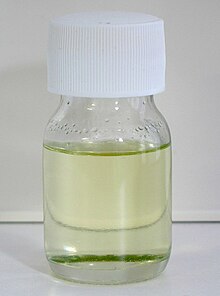
| |

| |

| |
| Names | |
|---|---|
| IUPAC name
Sulfuryl chloride
| |
| Other names
Sulfonyl chloride
Sulfuric chloride Sulfur dichloride dioxide | |
| Identifiers | |
3D model (JSmol)
|
|
| ChEBI | |
| ChEMBL | |
| ChemSpider | |
| ECHA InfoCard | 100.029.314 |
| EC Number |
|
| 2256 | |
PubChem CID
|
|
| RTECS number |
|
| UNII | |
| UN number | 1834 |
CompTox Dashboard (EPA)
|
|
| |
| |
| Properties | |
| SO2Cl2 | |
| Molar mass | 134.9698 g mol−1 |
| Appearance | Colorless liquid with a pungent odor. Yellows upon standing. |
| Density | 1.67 g cm−3 (20 °C) |
| Melting point | −54.1 °C (−65.4 °F; 219.1 K) |
| Boiling point | 69.4 °C (156.9 °F; 342.5 K) |
| hydrolyzes | |
| Solubility | miscible with benzene, toluene, chloroform, CCl4, glacial acetic acid |
Refractive index (nD)
|
1.4437 (20 °C)[1] |
| Hazards | |
| GHS labelling: | |
 
| |
| Danger | |
| H314, H335 | |
| P260, P261, P264, P271, P280, P301+P330+P331, P303+P361+P353, P304+P340, P305+P351+P338, P310, P312, P321, P363, P403+P233, P405, P501 | |
| NFPA 704 (fire diamond) | |
| Flash point | Not flammable |
| Related compounds | |
Related sulfuryl halides
|
Sulfuryl fluoride |
Related compounds
|
Thionyl chloride Chlorosulfonic acid Sulfuric acid |
Except where otherwise noted, data are given for materials in their standard state (at 25 °C [77 °F], 100 kPa).
| |
Sulfuryl chloride is an inorganic compound with the formula SO2Cl2. At room temperature, it is a colorless liquid with a pungent odor. Sulfuryl chloride is not found in nature, as can be inferred from its rapid hydrolysis.
Sulfuryl chloride is commonly confused with thionyl chloride, SOCl2. The properties of these two sulfur oxychlorides are quite different: sulfuryl chloride is a source of chlorine whereas thionyl chloride is a source of chloride ions. An alternative IUPAC name is sulfuryl dichloride.
- ^ Patnaik, P. (2002). Handbook of Inorganic Chemicals. McGraw-Hill. ISBN 978-0-07-049439-8.[page needed]
